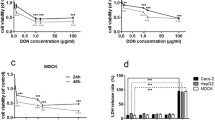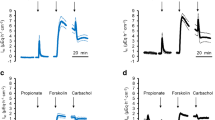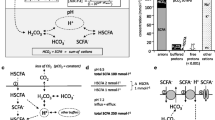Abstract
We investigated whether the uptake of triclopyr (3, 5, 6-trichloro-2-pyridinyloxyacetic acid) and dicamba (3,6-dichloro-2-methoxybenzoic acid) across the apical membrane of Caco-2 cells was mediated via proton-linked monocarboxylic acid transporters (MCTs). The uptake of triclopyr from the apical membranes was fast, pH-, temperature-, and concentration dependent, required metabolic energy to proceed, and was competitively inhibited by monocarboxylic acids such as benzoic acid and ferulic acid (substrates of l-lactic acid-insensitive MCTs), but not by l-lactic acid. Thus, the uptake of triclopyr in Caco-2 cells appears to be mediated mainly via l-lactic acid-insensitive MCTs. In contrast, the uptake of dicamba (a benzoic acid derivative) was slow, and it was both pH- and temperature dependent. Coincubation with ferulic acid did not decrease the uptake of dicamba, although coincubation with benzoic acid moderately decreased it. The uptake of dicamba appears to be mediated mainly via passive diffusion, which is in contrast to the uptake of benzoic acid via MCTs. We speculate that the substituted groups in dicamba may inhibit uptake via MCTs.




Similar content being viewed by others
References
Bradford MM (1976) A rapid and sensitive method for the quantitation of microgram quantities of protein utilizing the principle of protein-dye binding. Anal Biochem 72:248–254. doi:10.1016/0003-2697(76)90527-3
Buyse M, Sitaraman SV, Liu X, Bado A, Merlin D (2002) Luminal leptin enhances CD147/MCT-1-mediated uptake of butyrate in the human intestinal cell line Caco2-BBE. J Biol Chem 277:28182–28190. doi:10.1074/jbc.M203281200
Carmichael NG, Nolan RJ, Perkins JM, Davies R, Warrington SJ (1989) Oral and dermal pharmacokinetics of triclopyr in human volunteers. Hum Toxicol 8:431–437. doi:10.1177/096032718900800602
Endo T, Kimura O, Sasaya M, Takada M, Sakata M (1995) Na+- and energy-dependent transport of cadmium into LLC-PK1 cells. Biol Pharm Bull 18:1689–1693
Enerson BE, Drewes LR (2003) Molecular features, regulation, and function of monocarboxylate transporters: implications for drug delivery. J Pharm Sci 92:1531–1544. doi:10.1002/jps.10389
Gopal E, Miyauchi S, Martin PM, Ananth S, Roon P, Smith SB, Ganapathy V (2007) Transport of nicotinate and structurally related compounds by human SMCT1 (SLC5A8) and its relevance to drug transport in the mammalian intestinal tract. Pharm Res 24:575–584. doi:10.1007/s11095-006-9176-1
Hadjiagapiou C, Schmidt L, Dudeja PK, Layden TJ, Ramaswamy K (2000) Mechanism(s) of butyrate transport in Caco-2 cells: role of monocarboxylate transporter 1. Am J Physiol Gastrointest Liver Physiol 279:G775–G780
Halestrap AP, Price NT (1999) The proton-linked monocarboxylate transporter (MCT) family: structure, function and regulation. Biochem J 343:281–299. doi:10.1042/0264-6021:3430281
Itagaki S, Kobayashi Y, Otsuka Y, Kubo S, Kobayashi M, Hirano T, Iseki K (2005) Food-drug interaction between ferulic acid and nateglinide involving the Fluorescein/H+ cotransport system. J Agric Food Chem 53:2499–2502. doi:10.1021/jf047990i
Kimura O, Tsukagoshi K, Endo T (2008) Uptake of 4-chloro-2-methylphenoxyacetic acid (MCPA) from the apical membrane of Caco-2 cells by the monocarboxylic acid transporter. Toxicol Appl Pharmacol 227:325–330. doi:10.1016/j.taap.2007.10.028
Kimura O, Tsukagoshi K, Endo T (2009) Uptake of phenoxyacetic acid derivatives into Caco-2 cells by the monocarboxylic acid transporters. Toxicol Lett 189:102–109. doi:10.1016/j.toxlet.2009.05.006
Kolmodin-Hedman B, Höglund S, Swensson A, Akerblom M (1983) Studies on phenoxy acid herbicides. II. Oral and dermal uptake and elimination in urine of MCPA in humans. Arch Toxicol 54:267–273. doi:10.1007/BF01234479
Lappin GJ, Hardwick TD, Stow R, Pigott GH, Van Ravenzwaay B (2002) Absorption, metabolism and excretion of 4-chloro-2-metylphenoxyacetic acid (MCPA) in rat and dog. Xenobiotica 32:153–163. doi:10.1080/00498250110098940
Liang R, Fei YJ, Prasad PD, Ramamoorthy S, Han H, Yang-Feng TL, Hediger MA, Ganapathy V, Leibach FH (1995) Human intestinal H+/peptide cotransporter. Cloning, functional expression, and chromosomal localization. J Biol Chem 270:6456–6463. doi:10.1074/jbc.270.12.6456
Sai Y, Kaneko Y, Ito S, Mitsuoka K, Kato Y, Tamai I, Artursson P, Tsuji A (2006) Predominant contribution of organic anion transporting polypeptide OATP-B (OATP2B1) to apical uptake of estrone-3-sulfate by human intestinal Caco-2 cells. Drug Metab Dispos 34:1423–1431. doi:10.1124/dmd.106.009530
Takebe K, Nio J, Morimatsu M, Karaki S, Kuwahara A, Kato I, Iwanaga T (2005) Histochemical demonstration of a Na+ -coupled transporter for short-chain fatty acids (slc5a8) in the intestine and kidney of the mouse. Biomed Res 26:213–221. doi:10.2220/biomedres.26.213
Thwaites DT, Anderson CMH (2007) H+ -coupled nutrient, micronutrient and drug transporters in the mammalian small intestine. Exp Physiol 92:603–619. doi:10.1113/expphysiol.2005.029959
Timchalk C, Nolan RJ (1997) Pharmacokinetics of triclopyr (3, 5, 6-trichloro-2-pyridinyloxyacetic acid) in the beagle dog and rhesus monkey: perspective on the reduced capacity of dogs to excrete this organic acid relative to the rat, monkey, and human. Toxicol Appl Pharmacol 144:268–278. doi:10.1006/taap.1997.8136
Timchalk C, Dryzga MD, Kastl PE (1990) Pharmacokinetics and metabolism of triclopyr (3, 5, 6-trichloro-2-pyridinyloxyacetic acid) in Fischer 344 rats. Toxicology 62:71–87. doi:10.1016/0300-483X(90)90032-C
Tsuji A, Takanaga H, Tamai I, Terasaki T (1994) Transcellular transport of benzoic acid across Caco-2 cells by a pH-dependent and carrier-mediated transport mechanism. Pharm Res 11:30–37. doi:10.1023/A:1018933324914
van Ravenzwaay B, Hardwick TD, Needham D, Pethen S, Lappin GJ (2003) Comparative metabolism of 2, 4-dichlorophenoxyacetic acid (2, 4-D) in rat and dog. Xenobiotica 33:805–821. doi:10.1080/0049825031000135405
Yamaoka K, Tanigawara Y, Nakagawa T, Uno T (1981) A pharmacokinetic analysis program (MULTI) for microcomputer. J pharmacobio-Dyn 4:879–885
Acknowledgments
This study was supported by a Grant-in-Aid from Research for Promoting Technological Seeds (01-040).
Author information
Authors and Affiliations
Corresponding author
Rights and permissions
About this article
Cite this article
Kimura, O., Tsukagoshi, K., Hayasaka, M. et al. Uptake of triclopyr (3,5,6-trichloro-2-pyridinyloxyacetic acid) and dicamba (3,6-dichloro-2-methoxybenzoic acid) from the apical membranes of the human intestinal Caco-2 cells. Arch Toxicol 86, 55–61 (2012). https://doi.org/10.1007/s00204-011-0734-x
Received:
Accepted:
Published:
Issue Date:
DOI: https://doi.org/10.1007/s00204-011-0734-x




